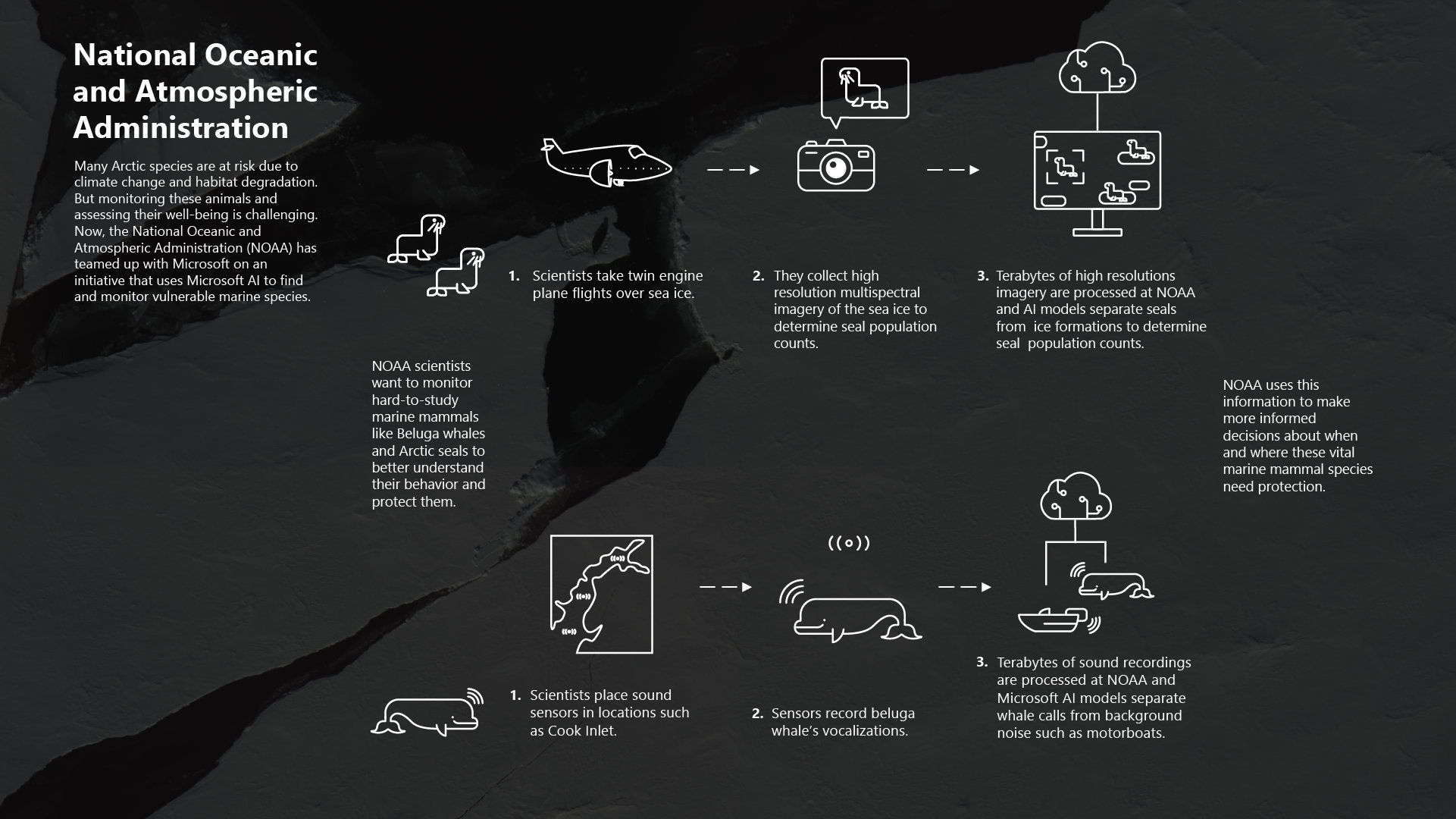NOAA preserves Alaskan marine life with the Cloud and AI
Downloads
Products
The frigid northern regions of our planet are teeming with wildlife. But many species—particularly marine species such as Beluga whales—are at risk due to climate change and habitat degradation. Tracking these animals and assessing their well-being is a daunting task, requiring surveys of thousands of square miles of ocean. Now, the National Oceanic and Atmospheric Administration (NOAA) has teamed up with Microsoft on an initiative that uses Cloud and AI to find and track endangered marine species.
Understanding impacts on marine life
For years, NOAA scientists with the Alaska Fisheries Science Center have struggled to transform vast quantities of data into meaningful information the center can use to understand and mitigate environmental impacts. “The National Marine Fisheries Service (NMFS, a division of NOAA) focuses primarily on fishery resources,” says Erin Moreland, a zoologist with NOAA. “Our job is to study these resources and regulate our use of those resources. Part of that is protecting species that aren't necessarily target species for the fishing industry but could be impacted by other human activities.”

It’s a big ocean out there
To achieve that, NMFS scientists take to the air and sea to find and collect data from species such as Beluga whales and various types of Arctic seals. But that is not an easy task. “We’re collecting images at a rate of one or two per second during a four-or five-hour flight,” says Josh London, a wildlife biologist with NOAA’s Alaska Fisheries Science Center (AFSC). “It’s a very tedious process to try to educate ourselves about what is out there so we can try to solve problems now rather than several years from now.”
Key to that would be finding a way to speed up the process of analyzing data. So, NOAA and its affiliated agencies turned to Microsoft to help.
AI does the heavy lifting
Take the challenge of studying Beluga whales, gregarious animals that have adapted to life in the Arctic and have been hunted for centuries. To learn more about them, NOAA has placed microphones along the bottom of Cook Inlet, a popular beluga hangout. The collected audio is uploaded and trains machine-learning models to distinguish the clicking sounds of belugas from other marine life, boat motors, or shifting ice. These machine-learning models can quickly analyze terabytes of undersea recordings.
“More than just saving human time, we’re now picking up signals we were missing with the previous detectors,” says Manuel Castellote, a scientist with AFSC. “That’s a great benefit to our analysis. Now if a company wants to start a new shipping lane or something like that, we can say that ‘based on our scientific knowledge,’ this is going to impact these species.’”
“One of the huge benefits in my mind to implementing artificial intelligence is freeing up the human mind to solve problems that computers can’t solve.”
Azure and AI make it possible
By uploading data to Azure, NOAA can scale up or reduce its data requirements as needed, without the cost and IT headaches of maintaining a local datacenter. In addition, Azure enables the high-performance computing NOAA needs for fast, accurate analysis of audio and video images. "One of the huge benefits in my mind to implementing artificial intelligence is freeing up the human mind to solve problems that computers can't solve," says Moreland.
NOAA now can use data-driven insights to provide timely scientific information that helps local governments make decisions that ensure marine life, and the environment, are not compromised by human activity. NOAA’s use of AI is helping local economies grow while protecting vulnerable species—one more way Microsoft is demonstrating the power of AI to analyze and enhance data.
Recommended Videos
US Navy FNMOC explores storm modeling for better decision-making
Learn how US Navy FNMOC leveraged Azure to prove tropical cyclone forecasting use case.
Explore our Technology Explainer Video page for overview videos explaining the emerging technology of today, including AI, Machine Learning, and more.
